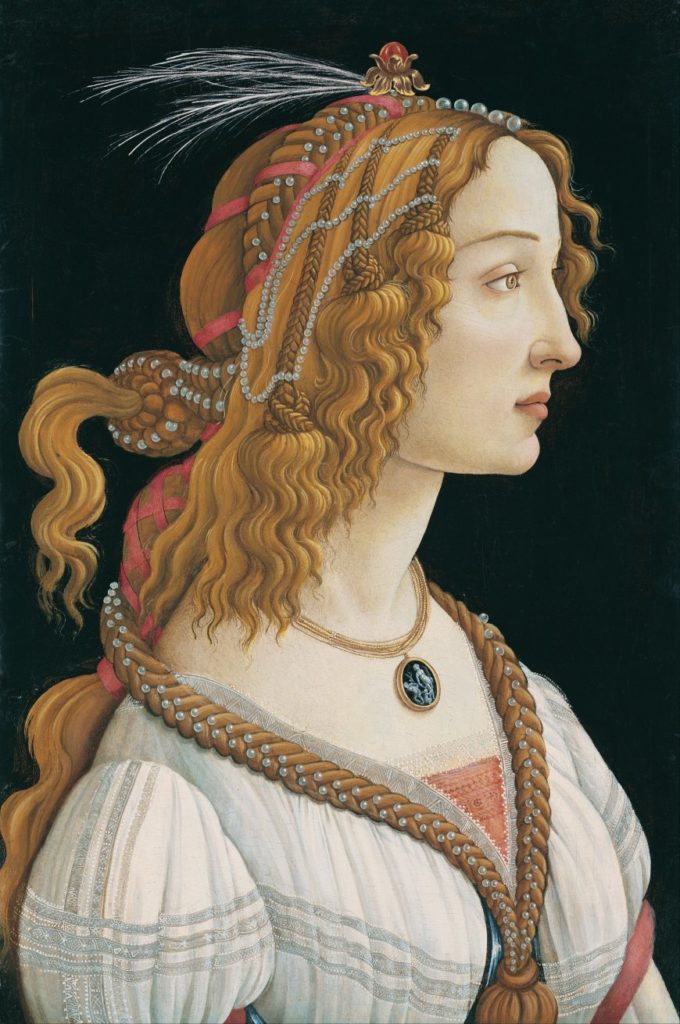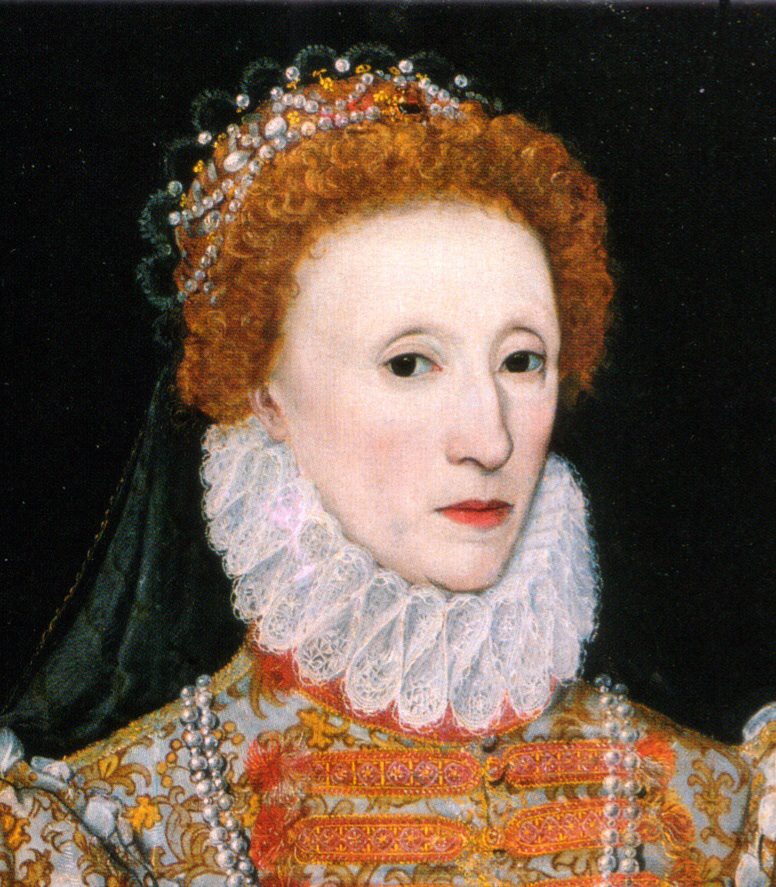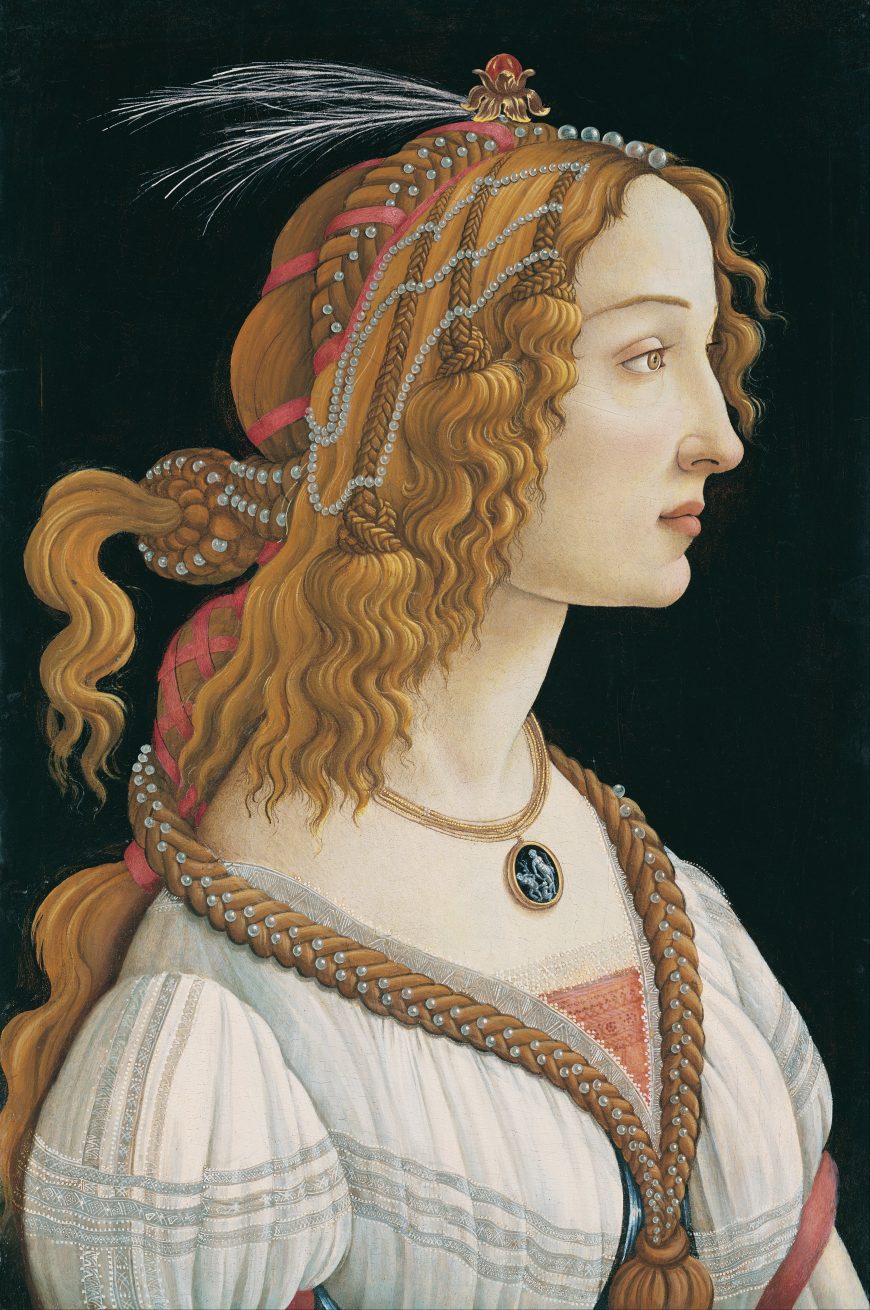MEDIEVAL TIMES, 500 to 1500 AD, in EUROPE
Cosmetics were widely used throughout the Middle Ages. Skin cleansers were made with animal fats, aloe vera, rosemary, and cucumbers; creams were made from seeds, honey, leaves, and flowers, and astringents were made with vinegar. Smooth, fair skin was achieved with herbal remedies that kept the face free from acne and pimples.
The RENAISSANCE, 14th to 17th centuries

Sandro Botticelli, ca 1480
The “Period of Enlightenment” emerged from the Dark Ages with a rebirth, a freedom, an innovation in all aspects of humanity—arts, with DaVinci and Michelangelo; music, architecture, philosophy, science, warfare—everything—and not the least of which was beauty. A simpler beauty was the new standard, a naturalness. The manufacture of modern cosmetics hearkens to this time in Italy and in France, with face powders and rouge, and no eye makeup. The timeless ingredients remained the same, though—honey, and oatmeal boiled in vinegar to treat blemishes, and bread soaked in rosewater. The first makeup brush was made from broomstalks.
ELIZABETHAN ENGLAND, 1558-1603

The “Darnley Portrait” of Queen Elizabeth I of England, National Portrait Gallery, London
Queen Elizabeth I, also known as the Virgin Queen, set the style for very white makeup foundation and red hair. She had naturally red hair, which she inherited from her father, Henry VIII, but the pancake makeup was for a profound reason: at the age of 29, Elizabeth suffered a near-fatal case of smallpox, which left her complexion scarred. Her solution was to apply of several layers of vinegar and lead-based whitening foundation, which was then powdered, to mask the pockmarks. Hygiene the way we observe it was not observed back then—men and women rarely washed their faces and body. To maintain the foundation, women simply added a fresh layer of powder. The built-up layers became difficult to wash off, and the most effective makeup remover proved to be urine. It was during the Elizabethan Era that doctors first associated facial tremors, muscle paralysis, and ulcers with the toxic effect of lead on skin. There is widespread conjecture that Queen Elizabeth may have died from lead poisoning. And yet, lead continued to be used in cosmetics until the 1860s and, in 1906 when with the formation of the Food and Drug Administration in America, it was legally banned.
BAROQUE PERIOD, 1600-1750
And so, Time marched on. Sweat cleansing, saunas, and milk baths were practiced among the aristocratic class to achieve smoother, clearer skin. Makeup was painted on the face in layers like paint—the heavier the makeup, the more respectable the woman. Rouge was so popular that it is estimated that two million pots were used by French women a year. To redden the lips, distilled alcohol or vinegar was applied to aggravate the skin.
VICTORIAN PERIOD, 1837-1901
The practical, modern approach to skincare can be attributed to the coronation of Queen Victoria of England. Hygiene, cleanliness, exercise, and skincare were all part of the daily routine of the Upper Classes. Facial cleansers were made from egg yolks, honey, and oatmeal. Chapstick, Vaseline, and baby powder were invented. Then, as always, and now, women feared aging and went to great lengths to appear young. Beauty salons were popular in Victorian England but rather than admit she needed help to achieve a youthful appearance, middle-aged matrons would enter the salons through the back door.
MODERN TIMES
The 1900s marks the explosion of the skincare industry. Products were available for all women, rich and poor alike. In 1907, Eugene Schueller, a young French chemist, invents modern synthetic hair dye and calls it L’Oréal. Chemist T. L. Williams invents mascara in 1915 and calls it Maybelline, after his sister. The Roaring Twenties introduces the flapper look, and French designer Coco Chanel launches her signature “look” with heavily made-up eyes, red lipsticks, red nail polish—and, for the first time in the history of skincare, advocates suntanned (not white or bleached) skin. In 1937, Carmex moisturizer was invented; sunscreen in 1944, and in 1946, Estee Lauder, the doyenne of modern skincare and cosmetics, created a new standard of beauty with a natural, healthy look that included tinted face powders for all complexions, including the outdoor glow from suntans. Madame C.J. Walker invented products specifically developed for black women. Both women made a fortune, becoming the two wealthiest self-made women of their day. Makeup and skincare products became a massive industry despite the Great Depression when brothers Charles and Joseph Revson found Revlon.
And then, in 1935, a Hollywood makeup artist named Max Factor comes along. And the rest, as they say, is history.

